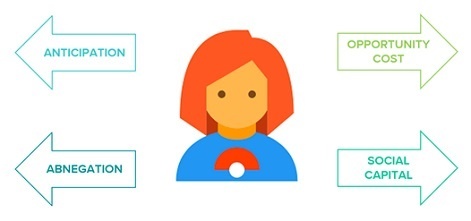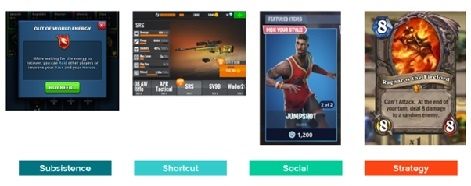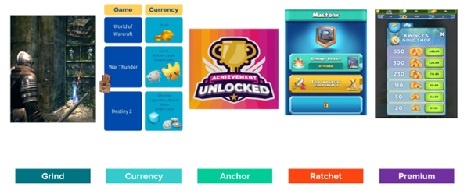Monetisation is important for any developer trying to scale their business, but successfully earning money in a game can be a daunting prospect. Not only does a developer need to consider which monetisation strategies to use in their games, but how to ensure that these monetisation strategies will be accepted by the playerbase and, crucially, what value their monetisation strategy adds to the game experience.
In this guest post, Fundamentally Games CEO Oscar Clark discusses how to build sustainable and effective monetisation strategies, and what a developer should keep in mind when trying to build a long-term revenue strategy.
A recent Sensor Tower report revealed that 78% of revenues in games are coming from service-based experiences, and yet we still find a lot of confusion over how to approach design and monetisation for keeping the interest of players in the long term. This even applies to games we, at Fundamentally Games, have pitched to us that we feel have great potential to become living games. In this article, Oscar Clark, CEO at Fundamentally Games and author of “Games As A Service” will explore some of the design thinking behind longer-term sustainable revenue models. Along the way, he hopes to show that the model can be plausible for smaller teams, without falling into the content treadmill, and how to focus on player value.
Why Do We Buy?
In 1960 R. Bauer wrote about ‘The role of risk in consumer behaviour’ which I think remains a great starting point to help understand why anyone buys anything; and just as importantly ‘why’ when they don’t! To heavily summarise the paper sets out to show that for any purchase we all need to mollify our own concerns that would otherwise prevent us from buying.

Basically, there are four core motivations that we need to engage before we will be willing to take the plunge and buy any item:
Anticipation: Unless I trust that the purchase will fulfil some desire, or value for me, I will not buy.
Opportunity Cost: If I don’t understand the cost of missing out by failing to act, I will not buy.
Social Capital: If I don’t see how this purchase contributes to my ‘social identity’ I will not buy.
Abnegation: If I have outside pressures or responsibilities which override my needs, I will not buy.
The last item ‘Abnegation’ is the one which causes the most consternation. As an example, I know I should be doing the washing up, but I “set aside my responsibilities” to play Fortnite and buy the battle pass because of the anticipation of the delight of playing the game and showing off the skins I’ve unlocked.
As designers of living games, we are looking to not just sell commodities but also to create engaging playing experiences, if we apply the same motivation principles to the core mechanics as we do when selling In-App Purchases. We can even go further to create contextual motivations that will sustain audiences over weeks, months, and years of play.
As players we instinctively understand the price in our time and effort that is driven by the anticipation or “Fear of Missing Out” that motivates us to play through the grind and unlock the next achievement or boss level. However, there is a real risk that this way of thinking will drive us into a content treadmill of endlessly making costly art assets that inevitably deteriorate in value for players.
Instead, we need to take a step back and find smarter ways to make more sustainable experiences, and still retain the fun/joy of the game.
Putting Player Value First

My first step is to look at the game through the player’s eyes and in general I think you can break this down into the following types of utility (meaning that thing which satisfies players “wants”):
Subsistence: What do players need and without which the game cannot progress, e.g. fuel, health, energy (even owning the game for a pay-upfront game).
Shortcuts: What power-ups, boosts, weapons, armour, vehicles, etc allow the player to complete tasks or otherwise sustain their game for longer.
Strategy: Discrete alternative modes/ways of playing which add extra value either as a mode of play or introduced through player loadouts.
Social: Opportunities for the player to show off their creativity, taste, or social identity within the game. Even a shared Lore can supply a social value – provided players care enough about the game.
Utility can take many forms but essentially comes down to whether access to the benefits are temporary (e.g. consumable items) or if they are lasting (e.g. durable or aspirational goods). Capacity and consumable generation can also play a part in this mix – something I have covered in previous articles on game monetisation. Just as important, however, is how the players access these elements, i.e. what is the form of exchange?
I typically consider the following forms exchanges:

Grind: The time and effort put in by the player in the game which delivers some form of ‘Currency’ or ‘Reward’. From a design point of view this can include the benefits of watching rewarded ads.
Currency: Some kind of resources e.g. Gems/Gold/XP that is earned through ‘Grind’ or purchased in bundles and provides a way to measure incremental earnings in the game that are converted into other more meaningful rewards. Terms like Soft and Hard Currency are used to reflect the spectrum between earning through play or paying to obtain these exchange items. In some cases you need specific currencies for specific purchase types (also known as resources)
Anchors: Specific currencies or rewards which can only be earned through actual play. They must never be possible to buy or otherwise be gifted or they lose their value. Anchors are a great way to ensure that we can easily balance an otherwise complex game economy.
Ratchets: Conditional tasks, items, achievements, or statuses that form the prerequisite for unlocking other items.
Premium: Of course, we can pay for items directly or indirectly through Battlepass or Subscription offers; indeed watching rewarded video (on mobile).
So what does this actually mean in practice, let's take a fantasy RPG-style game as an example:
I need more Health Potions (Subsistence) to be able to keep playing… I Grind in the game by taking the time to collect ingredients, including a rare flower (Anchor) that cannot be purchased. I then convert the results to health potions. Whilst I could buy Potions in bundles (Premium) I may be better off instead upgrading the Health Potion Recipe but that requires that I complete a specific mission (Ratchet) first. Alternatively, I could use leather (Resource) I collect to craft a potion belt (Capacity) which means I can carry more potions.
Understanding the flow of your whole game economy, not just the things you want to sell, is essential if you want to understand why players will want to spend not just once, but time and time again. I’d recommend doing a sync/source analysis to better understand how all these elements fit together, but again that’s for another article.
Configuration is Content
As well as wanting us to focus on what players want, the other reason I try to get designers to look at their games through the lens of player utility is that I want to explore the scope for repurposability. This is key to longer-term revenue models. It's too easy to fall into the trap of thinking that all you need to do is create more avatar customisation and you will make millions. Content is not just assets; content can also be configuration.
When we define our game we will have a variety of settings, configuration choices that make sure that the game works. Things like how quickly we jump and move, how much damage we (and any enemies) can take or give out, the level and value of rewards that we obtain when we are successful. This extends out to the objectives and missions we perform and even the animations which trigger when our character dies! Too often we bake these into the game itself, which allows us to play offline, but for longer-term sustainability it's important that we can update these settings via the server too.
The ability to change public variables related to the game combined with a well set-up content management server (CMS) that allows new assets to be downloaded on demand then repurposed depending on the backend server settings is super powerful. Not only does it mean that we can deliver new content without having to upload a new build, but combined with a scheduling tool can transform the longevity of your game. It will also allow you to avoid the content treadmill of just creating an endless stream of assets, instead focusing on the player’s experiences in the game.
With such a set-up we can think about the game as a journey rather than a completed experience. It can be useful to think more as a TV series rather than making a film, but I think that the autonomy in a game means we can be much more ambitious.
I think of games as Verbs, as in we “do”. This means that as a live-ops experience I am returning to replay the core mechanics of that game, but in order to drive forward against a renewing sense of purpose and progression over time. When a game sets us Daily/Weekly/Monthly challenges which allow us to feel a sense of momentum and collection over time, we deepen our engagement with that game. We will always crave some sense of achievement/completion, but with a living game the narrative or game lore can evolve over each season.
Let’s also not forget that players themselves are the best content. There is nothing like the effect of knowing that other people are playing, that they can see your achievements, and especially where you can interact with them whether that is synchronously or asynchronously in game, or via some online community experience.
Packaging long-term value
To continue to deliver player value over time we do need ongoing revenues, to pay for the servers, management of the LiveOps, new content and of course new features. This to me means that the revenue models need to also deliver more reason to play – not just as a way to capture money. Unlike the gym-membership model which gains profitability when users stop coming but fail to cancel their membership, we want to give paying players even more value from playing even more.
There are lots of ways to explore this, but I will focus on four examples:
Seasonality: A regular update of the game's lore, often associated with the release of updates to maps, focus on a specific character/weapons/faction or mode of play. Players may be able to temporarily gain access to new items/equipment even without paying, but upgrading or subscribing to the Season Pass allows them to keep those unique items (most of which will never return in exactly the same form).
Battlepass/VIP: Some kind of track made up of specific tasks or goals over the period of the pass, sometimes with specific activities tied to each week. These allow you to earn either specific rewards, or to generate a currency (sometimes unique to a season) for use in exchange for seasonal items. This approach has become a go-to standard, and perhaps even over-used. However, the principles of ongoing purpose can be adapted to most games with some imagination. VIP or premium paths which give VIPs more tasks to complete – allowing players to earn more value as they play more.
Prestige: A lot of games will find it difficult to provide the space for ongoing development of characters and skill trees over the longer term without creating significant balancing issues. However, there is a technique from idle games we can draw upon which will allow players to recapture the pleasure of progressing their favourite character times/skill trees. If players can ‘Prestige’ (or reset) a character, then they have to go back through the upgrading process – giving them a reason to play more. However, they will always need some return for doing that such as unlocking new skill paths, creating new abilities, increasing the optimisation of some other element of play. The specific added value will differ between different games e.g. a MOBA needs characters to start with a level playing field but playing options when they upgrade during a session can be more varied with ‘prestiged’ characters (as long as this doesn’t become unbalanced).
Competition: Creating competitive play moments, whether live multiplayer or asynchronous challenges is a key factor for so many games. My favourite example remains Golf Clash, as it allows for both scale and a sense of personal engagement with the 99 other players in my specific group. When I’m in the top 10 each week I get promoted, if I’m in the bottom 10 I get demoted. Combine that with special events which have some entry condition, e.g. VIP subscriber or having completed a specific tournament, etc allows that to become more commercial. However, even seasonal events which are linked to collaborative activities (e.g. Do more than X cumulative damage to the ‘Cerberus’ over a week) can be super interesting for engagement. They don’t necessarily have to be tied to a direct purchase to add value.
IN SUMMARY
Keeping players playing and paying for the game is an essential aspect for long-term revenue and keeping your game ‘living’. In order to do this, we need to thoroughly understand what players care about in your game and the flow of how they unlock those elements. Managing the ongoing player experience through scheduled configurations of game settings via the server allows you to schedule daily, weekly and monthly events and promotions without being stuck on a content treadmill.
However, more than that we need to always consider the Anticipation, Fear of Missing Out, and Social Capital aspects of every playing experience as the time players spend in our game, the currencies and resources they earn, as well as real-money investments all form part of the long-term experience. We need to build ongoing, sustainable delight if we want our games to have ongoing, sustainable revenues.
If you are interested in finding out more about the topic you can join Oscar’s free webinar on Tuesday 1st November.
About Oscar Clark
Oscar Clark literally wrote the book on Games as a service, and is Chief Strategy Officer at Fundamentally Games LTD, a publisher of living games committed to transparency and genuine partnership with developers.
About Fundamentally Games
Fundamentally Games Ltd was founded in 2019 to focus on bringing games to life, helping game developers with managing live operations to scale their game. Their engagement-led strategy aims to scale games faster by getting more players, doing more things, more often and for longer. Now offering publishing and UA funding with a commitment to transparency and genuine partnership with developers.
In March 2021 Fundamentally Games announced their UA Testing Program where they can fund testing and support for games early enough to make a difference.






















